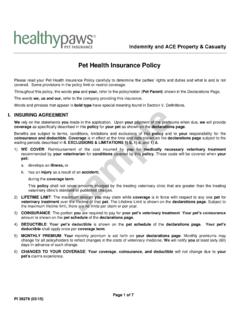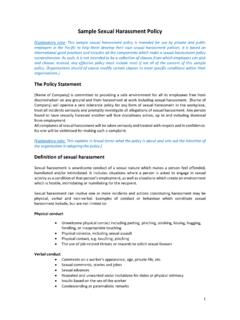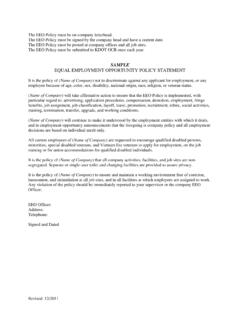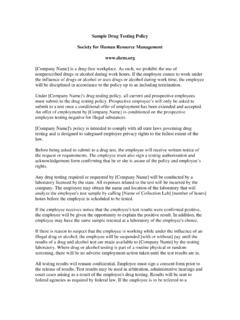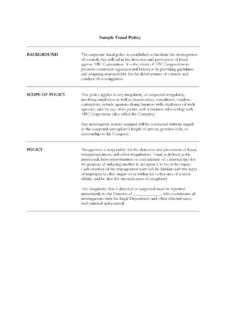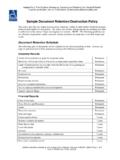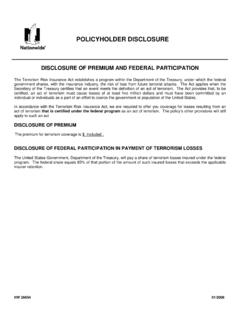Transcription of SAMPLE PAID TIME OFF POLICY - Nonprofit Network - Home
1 paid time OFF POLICY - 1 - paid time Off (PTO) provides you with the flexibility to use your time off to meet your personal needs, while recognizing your individual responsibility to manage your paid time off. You will accumulate a specified amount of PTO each pay period worked and it is up to you to allocate how you will use it for vacation, illness, caring for children, school activities, medical/dental appointments, leave, personal business or emergencies. The company may require you o use any unpaid PTO during disability or family medical leave, or any other leave of absence. The amount of PTO earned will depend on your length of your service with the Company.
2 [PTO does not replace the Company s holiday schedule. We will continue to have designated paid holidays each year.] ELIGIBILITY: You are eligible to receive PTO if you are a regular status employee scheduled to work at least _____ hours per week. [Part- time employees working more than _____ hours per week accrue PTO on a prorated basis, depending on the number of hours worked.] DEPOSITS INTO YOUR LEAVE ACCOUNT: The amount of PTO you accrue each year is based on your length of service and accrues according to the Accrual Schedule for full time employees chart below. PTO is accrued as you work. You will not accrue PTO time while you are on leave of absence or suspension by the Company.
3 ACCRUAL SCHEDULE FOR FULL time EMPLOYEES Years of Service Days Accrued Hours Accrued Maximum Annual Accrual (Hours) 0 - _____ _____ _____ _____ ____ - ____ _____ _____ _____ ____ + _____ _____ _____ - 2 - MAXIMUM time ACCUMUALTED: Although you may carry over unused PTO time from year to year, there is a cap on the amount of PTO time you can accumulate. This encourages you to use your PTO and allows the company to manage its financial obligations responsibly. Once you reach your cap, you will not accumulate any more PTO until you use some of the time in your account and drop below the cap. After your balance goes below the cap, you will begin accruing PTO again.
4 However, you will not receive retroactive credit for time worked while you were at the cap limit. PTO accrual is capped at one and one half times your annual PTO accrual rate. TERMINATION: You will be paid for all accrued but unused PTO when you leave the company. MANAGEMENT OF PTO: You are responsible for managing your PTO account. It is important that you plan ahead for how you will use it. This means developing a plan for taking your vacations, as well as doctor's appointments and personal business. It also means holding some time in "reserve" for the unexpected, such as emergencies and illnesses. MINIMUM INCREMENTS OF PTO: The minimum amount of PTO you can use at one time depends on whether you are an exempt or a non-exempt status employee.
5 If you are non-exempt, you may not take less than one hour off at a time . If you are an exempt status employee you must take PTO in increments of not less than one-half day. NOTICE AND SCHEDULING: You are required to provide your supervisor with reasonable advance notice and obtain approval prior to using PTO. This allows for you and your supervisor to prepare for your time off and assure that all staffing needs are met. There may be occasions, such as sudden illness, when you cannot notify your supervisor in advance. In those situations, you must inform your supervisor of your circumstances as soon as possible. - 3 - RECORDING paid time OFF: You must complete an Absence Report for all PTO time used.
6 We are required to track absences for illness, work related illness/injury, or the attendance of school related activities for legal compliance reasons. The amount of PTO accrued, used and available will appear on your paycheck stub. [ TRANSITION PROVISIONS: Most employees will start the new PTO banking system with an account balance consisting of all accrued old sick, personal, and vacation time . You will not lose any days if you come into the plan with a balance greater that your PTO cap. Employees who have hours over the maximum will continue to accrue PTO time and have one year to use time in excess of the maximum accrual. ]

![[name of organization] ETHICS POLICY](/cache/preview/f/f/2/9/d/9/b/c/thumb-ff29d9bccd08331254306a08f4ab475f.jpg)


